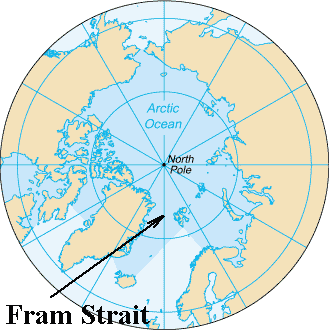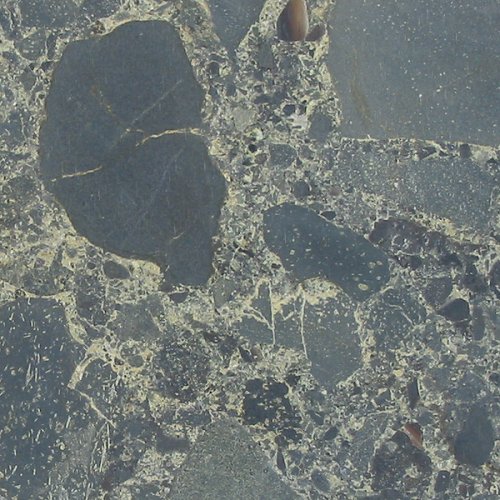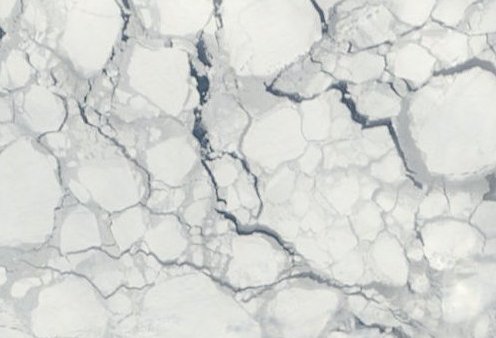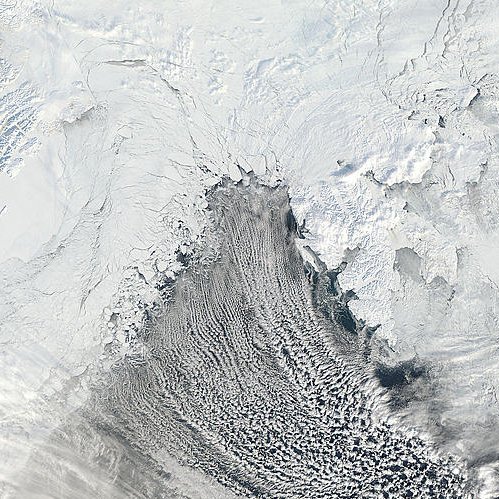Fram Jam Floe Flows
Lying between Greenland and Spitsbergen, Fram Strait is the major export path through which ice is lost from the main Arctic sea ice pack.
Ice floes flowing through Fram Strait sometimes flow freely and at other times jam together, choking the Strait and slowing down the rate of ice export.
In this article I attempt to show how studying the behavior of sea ice as a material which exists in many forms can lead to a better understanding of the dynamics of Arctic sea ice export.

Location of Fram Strait
Granules and aggregates
A granular material has specific properties which control how it behaves when forced to pass through a constriction. The same material can have a quite different range of properties if it is embedded in a matrix. For example, a dry mixture of sand and stones can easily pass through an aperture which is sufficient in area. However, if the aperture is only just large enough to pass a single stone of the largest size, any two such stones can block the aperture. As smaller particles fill the interstices, the flow eventually ceases.
If the sand and stones are wetted, then the rate of flow through an aperture sufficiently large for a dry mix will slow, and may cease. Add cement to the mix and you have concrete. Concrete can creep, but it cannot flow through an aperture - unless it is first shattered by strong forces. Mortar is not at all as strong as concrete. In the extreme case, a weak mix of sand and cement is quite friable: little force is needed to reduce it to dust.
When concrete fractures, the type of fracture depends on the strength of the concrete and the size of the aggregate particles. Concrete made from smaller aggregates will tend to fracture along the cement matrix - that is, cracks will propagate around the aggregate. In the case of large aggregate such as is used for the building of dams, sufficiently strong forces will cause cracks to propagate through the aggregate.
Nature's own variants of concrete are known as conglomerates and breccias. Here is an image of basalt breccia.

Basalt breccia
Image courtesy Wikimedia Commons
The similarity between a satellite image of ice sheets and a section through concrete, conglomerate or breccia is striking.
As with stone, so with sea ice: cracks in sea ice can propagate through new ice along the edges of what were previously separate floes. In ice where the floes are cemented together with older ice, cracks are more likely to propagate straight through the whole sheet. The two MODIS images below show the contrast between the two types of crack propagation.

Leads forming in young ice around old floes

Leads forming across floes in older ice
As ice breaks up into ever smaller floes it becomes less resistant to movement. Formerly the broken ice was confined to relatively narrow ice margins around a central mass consisting mainly of vast sheets of old, thick ice. Of recent years the margin has become more extensive, allowing waves and swell to penetrate further into the main pack. Greater mobility appears to be a positive feedback to greater fragmentation.
Although floes can be dispersed by winds and currents towards open water, there are many islands, narrow channels and coasts around the Arctic which hinder the outflow of ice. Fram Strait presents a geologically wide passage for ice export. However, the strait is usually severely constricted as ice jams form and hinder the free flow of ice.
The dynamics of ice flows through Fram Strait
Historically, ice flowing south from Fram Strait followed Greenland's east coast as it was carried along by the current. On reaching the southern tip of Greenland at Cape Farvel, the ice flowed up the west coast. A study1 published in 2003 reports:
Historical observations of multiyear ice, called "storis," in the southwest Greenland waters exist from the period 1820–2000, obtained from ship logbooks and ice charts. It is argued that this ice originates in the Arctic Ocean and has traveled via the Fram Strait, southward along the Greenland coast in the East Greenland Current, and around the southern tip of Greenland.

Fram Strait March 30 2011 - 2km resolution
Although the wind is seen to be blowing away from the ice, the stream of ice flowing south remains close to the coast - or to the coastal ice - of Greenland. It appears that the drift due to current dominates the drift due to wind. The coriolis effect will also be a significant factor in pressing the ice towards Greenland.
The ice pressed against the coast of Greenland forms a tight stream of floes - it is almost as if the ice is forced to flow through an invisible chicane. It appears that a 'backlog' of ice can build up so as to slow or block ice export over about half the width of Fram Strait. When the backlog continues back to the region of Flade Isblink it appears that it can deflect the ice stream coming from the direction of Cap Morris Jessup towards Spitsbergen.

Ice jam in Fram Strait March 30 2011 - 1km resolution
mass flux
energy source - advection wind current
energy storage - compression / shear
threshold - friction / shear
relaxation - avalanche
slowly driven - usually
threshold dynamics - (tipping point)
relaxation event dissipates energy
statisticall stationary ice where in flux = out flux
relaxation event followed by steady flow or flow stall.
like rain - trickle or torrent
metastability
Almost any system can demonstrate metastability, but it is most prevalent in systems of weakly interacting particles
weak interaction between particles is the only energy barrier that must be overcome for the system to reach a lower-energy state
http://en.wikipedia.org/wiki/Angle_of_repose
slump angle
http://en.wikipedia.org/wiki/Concrete_slump_test
granular Maxwell's Demon
jamming - ice bridge
agglomeration
aggregate + matrix
matrix cracking
strength as function of particulate size and strength
cracks around or through inclusions
ice gains and losses - pseudo-equilibrium
pseudo because -
non-isolated system
dilatency
avalanches dissipate energy
post-avalanche turbulence
anisotropy
avalanche and slump angle - oslo rice pile experiment.
self organised criticality


